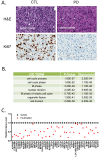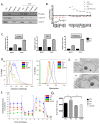Defining the transcriptional and biological response to CDK4/6 inhibition in relation to ER+/HER2- breast cancer
- PMID: 27564114
- PMCID: PMC5342463
- DOI: 10.18632/oncotarget.11588
Defining the transcriptional and biological response to CDK4/6 inhibition in relation to ER+/HER2- breast cancer
Abstract
ER positive (ER+) and HER2 negative (HER2-) breast cancers are routinely treated based on estrogen dependence. CDK4/6 inhibitors in combination with endocrine therapy have significantly improved the progression-free survival of patients with ER+/HER2- metastatic breast cancer. Gene expression profiling in ER+/HER2- models was used to define the basis for the efficacy of CDK4/6 inhibitors and develop a gene expression signature of CDK4/6 inhibition. CDK4/6 inhibition robustly suppressed cell cycle progression of ER+/HER2- models and complements the activity of limiting estrogen. Chronic treatment with CDK4/6 inhibitors results in the consistent suppression of genes involved in cell cycle, while eliciting the induction of a comparable number of genes involved in multiple processes. The CDK4/6 inhibitor treatment shifted ER+/HER2- models from a high risk (luminal B) to a low risk (luminal A) molecular-phenotype using established gene expression panels. Consonantly, genes repressed by CDK4/6 inhibition are strongly associated with clinical prognosis in ER+/HER2- cases. This gene repression program was conserved in an aggressive triple negative breast cancer xenograft, indicating that this is a common feature of CDK4/6 inhibition. Interestingly, the genes upregulated as a consequence of CDK4/6 inhibition were more variable, but associated with improved outcome in ER+/HER2- clinical cases, indicating dual and heretofore unknown consequence of CDK4/6 inhibition. Interestingly, CDK4/6 inhibition was also associated with the induction of a collection of genes associated with cell growth; but unlike suppression of cell cycle genes this signaling was antagonized by endocrine therapy. Consistent with the stimulation of a mitogenic pathway, cell size and metabolism were induced with CDK4/6 inhibition but ameliorated with endocrine therapy. Together, the data herein support the basis for profound interaction between CDK4/6 inhibitors and endocrine therapy by cooperating for the suppression of cell cycle progression and limiting compensatory pro-growth processes that could contribute to therapeutic failure.
Keywords: CDK4/6; PAM50; RB-pathway; breast cancer; molecular subtypes.
Conflict of interest statement
There is no conflict of interest.
Figures






Similar articles
-
MDM2 inhibition in combination with endocrine therapy and CDK4/6 inhibition for the treatment of ER-positive breast cancer.Breast Cancer Res. 2020 Aug 12;22(1):87. doi: 10.1186/s13058-020-01318-2. Breast Cancer Res. 2020. PMID: 32787886 Free PMC article.
-
Resistance to cyclin-dependent kinase (CDK) 4/6 inhibitors confers cross-resistance to other CDK inhibitors but not to chemotherapeutic agents in breast cancer cells.Breast Cancer. 2021 Jan;28(1):206-215. doi: 10.1007/s12282-020-01150-8. Epub 2020 Aug 28. Breast Cancer. 2021. PMID: 32860163 Free PMC article.
-
NF1-depleted ER+ breast cancers are differentially sensitive to CDK4/6 inhibitors.Sci Transl Med. 2025 Aug 27;17(813):eadq5492. doi: 10.1126/scitranslmed.adq5492. Epub 2025 Aug 27. Sci Transl Med. 2025. PMID: 40864686
-
Targeting Cell Cycle in Breast Cancer: CDK4/6 Inhibitors.Int J Mol Sci. 2020 Sep 4;21(18):6479. doi: 10.3390/ijms21186479. Int J Mol Sci. 2020. PMID: 32899866 Free PMC article. Review.
-
Cyclin-dependent kinase 4 and 6 inhibitors in hormone receptor-positive, human epidermal growth factor receptor-2 negative advanced breast cancer: a meta-analysis of randomized clinical trials.Breast Cancer Res Treat. 2020 Feb;180(1):21-32. doi: 10.1007/s10549-020-05528-2. Epub 2020 Jan 22. Breast Cancer Res Treat. 2020. PMID: 31970560 Review.
Cited by
-
ITPKC as a Prognostic and Predictive Biomarker of Neoadjuvant Chemotherapy for Triple Negative Breast Cancer.Cancers (Basel). 2020 Sep 25;12(10):2758. doi: 10.3390/cancers12102758. Cancers (Basel). 2020. PMID: 32992708 Free PMC article.
-
The E2F Pathway Score as a Predictive Biomarker of Response to Neoadjuvant Therapy in ER+/HER2- Breast Cancer.Cells. 2020 Jul 8;9(7):1643. doi: 10.3390/cells9071643. Cells. 2020. PMID: 32650578 Free PMC article.
-
Cyclin E1 and Rb modulation as common events at time of resistance to palbociclib in hormone receptor-positive breast cancer.NPJ Breast Cancer. 2018 Nov 28;4:38. doi: 10.1038/s41523-018-0092-4. eCollection 2018. NPJ Breast Cancer. 2018. PMID: 30511015 Free PMC article.
-
Inhibiting CDK in Cancer Therapy: Current Evidence and Future Directions.Target Oncol. 2018 Feb;13(1):21-38. doi: 10.1007/s11523-017-0541-2. Target Oncol. 2018. PMID: 29218622 Review.
-
The prognostic value of quantitative analysis of CCL5 and collagen IV in luminal B (HER2-) subtype breast cancer by quantum-dot-based molecular imaging.Int J Nanomedicine. 2018 Jun 28;13:3795-3803. doi: 10.2147/IJN.S159585. eCollection 2018. Int J Nanomedicine. 2018. PMID: 29988769 Free PMC article.
References
-
- Pritchard KI, Sutherland DJ. The use of endocrine therapy. Hematol Oncol Clin North Am. 1989;3:765–805. doi: - PubMed
MeSH terms
Substances
Grants and funding
LinkOut - more resources
Full Text Sources
Other Literature Sources
Medical
Molecular Biology Databases
Research Materials
Miscellaneous

